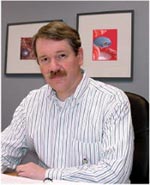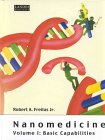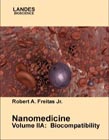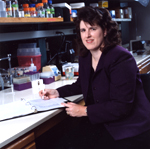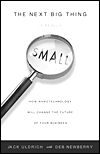|
In this issue of NanoNews-Now Editor Rocky Rawstern covers Life Extension and Nanotechnology, via interviews with Author Douglas Mulhall, Robert A. Freitas Jr., (Nanomedicine), and Mike Treder, Executive Director of CRN.
For another look into the future, we present a section of our Best of 2003 Awards, featuring Dr. Naomi Halas and Dr. Jennifer West of Rice University, and their remarkable gold nanoparticles.
Join us as we present "Life Extension and Nanotechnology"
|
 Would knowing the status of patents and patents pending coming out of universities benefit your company? Would having a single database within which to learn how to contact the right person at each technology transfer office be useful?
Would knowing the status of patents and patents pending coming out of universities benefit your company? Would having a single database within which to learn how to contact the right person at each technology transfer office be useful?
Nanotechnology Now is pleased to offer the NanoTech-Transfer Monthly Report and Database.
The NanoTech-Transfer product is an excellent tool, as it provides up to date information on what institutions and what individuals are actively involved in filing nanotechnology intellectual property. It provides me with the information I need to stay in touch with the leaders in the field. Great product.
—Douglas W. Jamison, Vice President Harris & Harris Group Inc. hhgp.com
A year's subscription includes 12 issues of our monthly report published on the last Friday of the month, and access to our patent database.
NanoTech-Transfer Patent Database
Full search Database - search by tech-sector, inventor, institution, application, patent number or date.
NanoTech-Transfer Report
Each monthly issue of the NanoTech Transfer Report delivers detailed information on the latest nanotech patents and patents pending from individuals, universities and research institutes from around the world.
Click Here For Details
|
|
Table of contents:
LE&N
Douglas Mulhall
Robert Freitas
Mike Treder
Halas / West
Quotes
Next Issue
Glossary
NanoStrategies
NanoTech-Transfer
NanoNews Digest
About Us
Contact
|
NanoNews-Now Editorial Calendar
|
|
Oct '04 |
Space Elevator |
|
Nov '04 |
Investments |
|
Dec '04 |
Self Assembly |
|
Jan '05 |
Patents |
|
Tentative Schedule 2005 |
|
Feb '05 |
MNT |
|
Mar '05 |
Memory and Chip Tech |
|
Apr '05 |
Jobs |
|
May '05 |
Education |
|
Jun '05 |
Tools |
|
Jul '05 |
Investments |
|
Aug '05 |
Security |
|
Sep '05 |
Life Extension |
|
Oct '05 |
Military |
|
Nov '05 |
Materials |
|
Dec '05 |
Possible Futures |
|
Life Extension and Nanotechnology
Applying tiny tech to medicine
|

By Rocky Rawstern
|
Many reasonable and credible scientists predict a rosy medical future for mankind, crediting it in large part to advances in nanoscale technologies.
Every day we learn more about the remarkable and remarkably different properties of the nanoscale. And our tools keep getting better, at a faster and faster rate, able to focus further and further into increasingly minute dimensions. As a result, scientists are discovering a wealth of new applications, many of them being tested at this time, and many destined to become legendary breakthroughs in medicine.
These things herald a time when disease is diagnosed and treated much faster, with less cost, and with fewer - to no - side effects.
We are entering an era where we now know enough to apply nanotechnology to medical purposes. It is speculated that very soon doctors will be able to diagnose disease - and in many cases start treating it - right in their offices, real-time.
As we highlighted in our Best of 2003 Awards, researchers are well on their way to developing solutions to age-old medical problems. They are finding ways to apply tiny technology to medicine by devising sensors and treatments that take advantage of the unique laws and possibilities of the nanoscale, and using materials in unique ways.
While nanorobots that cruise around in our bloodstreams and tissues are further down the road, we see a glimmer of their promise in today's latest discoveries. We also continue to uncover science that suggests they are indeed possible, in one form or another, safely.
Some of the promising research going on today includes:
- Disease detection tool the size of today's Palm Pilots
- Quantum dots to boost tissue imaging capabilities, including 3-D imaging
- Protein-binding nanoparticles to simplify mass spectrometry
- Nanoparticles to diagnose diseases such as prostate and breast cancer, Alzheimer's, HIV, and many others
- Nanoparticles that deliver drugs, and are used for medical imaging and gene detection
- Nanocrystals attached with snippets of DNA used to target defective genes
- Buckyballs as targeted antibiotics, creating a new line of defense against bioweapons like anthrax
- Functioning vascular system, as a step towards creating new organs
- Nanomaterials that mimic bone, and are used to heal breaks and fractures
- Nanoscale devices to analyze a genome in minutes
- Zirconia-toughened alumina nanocomposites to form ceramic implants with potential life-spans of > 30 years
And the U.S. government has formerly gotten into the game with the newly created NCI Alliance for Nanotechnology in Cancer.
"Towards the end of eliminating suffering and death from cancer, the National Cancer Institute is engaged in efforts to harness the power of nanotechnology to radically change the way we diagnose, image and treat cancer."
"NCI programs conducted over the past five years have supported research on novel nanodevices that may detect and pinpoint the location of cancer at its earliest stages, deliver anticancer drugs specifically to malignant cells, and determine in real-time if these drugs are effective in killing malignant cells."
"We envision that nanotechnology will change the very foundations of cancer diagnosis, treatment and prevention." (Our emphasis)
To help meet the Challenge Goal of eliminating suffering and death from cancer by 2015, the National Cancer Institute (NCI) is engaged in a concerted effort to harness the power of nanotechnology to radically change the way we diagnose, treat, and prevent cancer. Over the past 5 years, the NCI has taken the lead in integrating nanotechnology into biomedical research through a variety of programs. The results of these initial funding efforts have demonstrated clearly that melding nanotechnology and cancer research and development efforts will have a profound, disruptive effect on how we diagnose, treat, and prevent cancer.
— Andrew C. von Eschenbach, M.D., Director, National Cancer Institute
What does the NCI Alliance for Nanotechnology in Cancer think it can accomplish with nanotechnology?
- Imaging agents and diagnostics that will allow clinicians to detect cancer in its earliest stages
- Systems that will provide real-time assessments of therapeutic and surgical efficacy for accelerating clinical translation
- Multifunctional, targeted devices capable of bypassing biological barriers to deliver multiple therapeutic agents directly to cancer cells and those tissues in the microenvironment that play a critical role in the growth and metastasis of cancer
- Agents that can monitor predictive molecular changes and prevent precancerous cells from becoming malignant
- Novel methods to manage the symptoms of cancer that adversely impact quality of life
- Research tools that will enable rapid identification of new targets for clinical development and predict drug resistance
Visit their video center to see A Video Journey into the World of Nanotechnology in Cancer.
What about the further into the future?
From Robert A. Freitas Jr. we learned the following about nanorobots:
Improved Human Abilities
Another major change that nanomedicine will bring is the ability to dramatically extend natural human capabilities. As a simple example, a few years ago I designed an artificial mechanical red cell called a "respirocyte." Still entirely theoretical, the respirocyte measures 1 micron in diameter and just floats along in the bloodstream. It is a spherical nanorobot made of 18 billion atoms precisely arranged in a diamondoid structure to make a tiny pressure tank that can be pumped full of up to 3 billion oxygen (O2) and carbon dioxide (CO2) molecules. Later on, these gases can be released from the tank in a controlled manner using tiny molecular pumps. Gases are stored onboard at pressures up to about 1000 atmospheres.
Respirocytes mimic the action of the natural hemoglobin-filled red blood cells. Gas concentration sensors on the outside of each device let the nanorobot know when it is time to load O2 and unload CO2 (at the lungs), or vice versa (at the tissues). Each respirocyte can store and transport 236 times as much gas per unit volume as a natural red cell. So the injection of a 5 cc therapeutic dose of 50% respirocyte saline suspension, a total of 5 trillion individual nanorobots, into the human bloodstream can exactly replace the gas carrying capacity of the patient's entire 5.4 liters of blood. But up to 1 liter of respirocyte suspension could safely be added to the bloodstream, which could keep a patient's tissues safely oxygenated for up to 4 hours in the event a heart attack caused the heart to stop beating. Or it would enable a healthy person to sit quietly at the bottom of a swimming pool for four hours, holding his breath, or to sprint at top speed for at least 15 minutes without breathing.
|
Medical applications of nanotechnology could eventually make possible subcellular medical nanorobots able to hunt down and kill cancer cells, clear out clogged arteries, provide oxygen during a heart attack, attack and destroy invading bacteria and viruses or even reverse the damage caused by aging. Foresight Update 40
|
Similarly, an artificial mechanical platelet or "clottocyte" could make possible complete hemostasis in just 1 second, even for moderately large wounds, a response time 100-1000 times faster than the natural system. The basic clottocyte is conceived as a serum oxygen/glucose-powered spherical nanorobot, 2 microns in diameter, that contains a compactly-folded fiber mesh. Upon command from its control computer, the device unfurls its mesh packet in the vicinity of an injured blood vessel - following, say, a cut through the skin. Soluble thin films coating certain parts of the mesh dissolve upon contact with plasma water, revealing sticky sections (e.g., complementary to blood group antigens unique to red cell surfaces) in desired patterns. Blood cells are immediately trapped in the overlapping artificial nettings released by multiple neighboring activated clottocytes, and bleeding halts at once. While up to 300 natural platelets might be broken and still be insufficient to initiate a self-perpetuating clotting cascade, even a single clottocyte, upon reliably detecting a blood vessel break, can rapidly communicate this fact to its neighboring devices, immediately triggering a progressive carefully-controlled mesh-release cascade.
Clottocytes may perform a clotting function that is equivalent in its essentials to that performed by biological platelets, but at only 0.01% of the bloodstream concentration of those cells or about 20 nanorobots per cubic millimeter of serum. Hence clottocytes appear to be about 10,000 times more effective as clotting agents than an equal volume of natural platelets.
|
The injection of 5 trillion nanorobots into the human bloodstream requires only a 5 cc therapeutic dose. "Do you 'feel' heavier after you drink a mouthful of water? A mouthful of water, roughly 5 cm^3, would have the same mass as a ~2 terabot (a 2 trillion nanorobot) dose of 1 micron^3 nanorobots. You'll never feel it." says Freitas.
|
Chromosome Replacement Therapy
Medical nanorobots will also be able to intervene at the cellular level, performing in vivo cytosurgery. The most likely site of pathological function in the cell is the nucleus - more specifically, the chromosomes. In one simple cytosurgical procedure, a nanorobot controlled by a physician would extract existing chromosomes from a diseased cell and insert new ones in their place. This is called chromosome replacement therapy. The replacement chromosomes will be manufactured to order, outside of the patient's body in a laboratory benchtop production device that includes a molecular assembly line, using the patient's individual genome as the blueprint.
The replacement chromosomes are appropriately demethylated, thus expressing only the appropriate exons that are active in the cell type to which the nanorobot has been targeted. If the patient chooses, inherited defective genes could be replaced with nondefective base-pair sequences, permanently curing a genetic disease. Given the speed with which nanorobots can be administered and their potential rapidity of action, it is possible that an entire whole-body procedure could be completed in one hour or less. Robert Austin at Princeton University has also begun early thinking along these lines, hoping someday to design a nanoprobe capable of identifying biological markers that are specific for targeted diseases. "Then you just pop open the cells, remove the bad DNA from that cell, and repair it on a single-cell level," he says. "That's a long way down the road, but it will happen."
In the first half of the 21st century, nanomedicine should eliminate virtually all common diseases of the 20th century, and virtually all medical pain and suffering as well. Only conditions that involve a permanent loss of personality and memory information in the brain - such as an advanced case of Alzheimer's disease or a massive head trauma - may remain incurable in the nanomedical era. Because aging is believed to be the result of a number of interrelated molecular processes and malfunctions in cells, and because cellular malfunctions will be largely reversible, middle-aged and older people who gain access to an advanced nanomedicine can expect to have most of their youthful health and beauty restored. And they may find few remaining limits to human longevity in this wonderfully vigorous state. It is a bright future that lies ahead for medicine, but we shall all have to work very long and very hard to bring it to fruition.
According to Freitas, these are just a few of the many nanorobots that we will see in our future. For a more complete list, visit the Nanomedicine Book Site. For questions regarding nanomedicine, visit the Nanomedicine FAQ. And to see artistic renditions of nanorobots, visit the Nanomedicine Art Gallery, and Our's.
All of these advances - both near-term and future - foretell of a time when we live longer, healthier lives, paying less attention to disease and trauma, and more to leisure activities and learning.
We close this section with the following:
How will nanotechnology change people's lives?
All spheres of life will be affected by it, but particularly the field of medicine. That's because life itself is applied nanotechnology. In the course of billions of years, evolution has learned to optimally exploit its materials on the atomic level. Modeled after this principle, for example, are DNA chips for diagnosing diseases, or biocompatible implants.
—Professor Wolfgang Heckl (in an interview in research, the Bayer Scientific Magazine)
NN: How do you define the term "nanotechnology?"
There has always been an argument around the definition. Nanotechnology at its simplest consists of manipulating materials precisely at the molecular or atomic level. However, the disagreement centers on how sophisticated we can get at such manipulation: Can we do it in three dimensions, can we program small machines to self-replicate, and can we instruct those self-replicating machines to build other more complex ones?
Now, the discussion has moved in the direction that I forecast in my book, Our Molecular Future - where the line between biology and inorganic nanotechnology is disappearing.
Mainstream nanotechnologists have described the Eric Drexler definition of nanotechnology - i.e. self replicating nanobots that can assemble large complex machines - as unrealistic. Yet now, we are moving closer to self-assembly at an accelerating pace.
This shouldn't be a surprise. Natural molecular assembly has gone on for millions of years, and we're now figuring out how that happens. It's known as DNA. It consists of a compact software package that instructs chemicals to form molecules than then form sophisticated self-replicating machines. These machines then build living machines known as "us."
Unfortunately, some nanotechnologists think that nanotech is limited to electro-mechanical machines and inorganic chemistry, but this just isn't right.
Today for example, an early form of molecular assembly is being used in industrial technologies such as photovoltaics manufacturing. Self-assembling photovoltaic films are created from liquid organic plastics. We can program chemicals to organize themselves into organic networks that produce electricity.
We've also seen recently that researchers at Purdue University are studying nucleic acid as a model for molecular assembly.
So, the argument over the definition of nanotechnology is becoming moot, because we are heading quickly to self-replicating and self-assembling structures.
The line between organic and inorganic is disappearing. This means that we can learn a lot from how natural nanotechnology works.
That in turn takes us to naturally occurring nano-particles such as nanobacteria.
|
The real question for near-term life extension is not so much nanobots and replacing limbs but instead getting rid of disease. Waterborne contaminants are still responsible for most of the leading causes of death in the world from infectious diseases. Nanofilteration may let us get rid of them cheaply. Then before we get rid of the rest of these diseases that shorten our lives we have to know the cause. Incredibly we still do not know the cause of most diseases on the 'leading causes of death' list. How many of the leading causes of death today are infectious or spawned by infection? Authors such as Paul Ewald argue that infection is the basis for cancers and heart disease that together kill most of us. How is high technology helping us to unravel this mystery?
Imagine for example the longevity impacts if calcification were eliminated from heart disease, cancers, kidney stones, arthritis and a host of other illnesses. That is the relevance of The Calcium Bomb to the longevity discussion. For example, the U.S. Surgeon general estimates that by getting rid of heart disease alone the average lifespan would immediate increase by five years.
|
NN: Please describe nanobacteria, its nanotechnology connection, and the controversy surrounding it. Who discovered it? Who believes it contributes to heart disease? Which studies indicate a link? Who are its detractors, and what evidence or theory do they use?
These questions are answered in my upcoming co-authored book The Calcium Bomb: The Nanobacteria Link to Heart Disease and Cancer (The Writers Collective 2004).
First, let's talk about why this is important. One of the most widespread chronic medical conditions in the western hemisphere is known as calcification. It happens when calcium phosphate gets into the wrong parts of the body and damages human tissue. It is a dangerous indicator of cancer, heart disease, arthritis, gum disease, and of sport injuries that heal badly. Until now, doctors have not known where it came from or how to get rid of it.
Calcification is perhaps one of the most significant parts of the life extension discussion, because the diseases that calcification is associated with constitute the biggest killers as we reach old age, and also start to cause trouble when we are young.
Ironically, until now no popular book has been published about calcification despite its pervasiveness in disease, and despite thousands of scientific research papers being written about it.
Until recently, no virus or bacterium had been shown to produce calcium phosphate under normal blood-like conditions. So researchers were stumped over where the deposits came from. Now, the discovery of nanobacteria has changed that picture dramatically.
What are they?
Nanobacteria are probably not bacteria at all. They were mis-labeled when they were provisionally named in the late 1980s and scientists didn't know many of their properties. After it was discovered that they had non-bacterial properties, the name still stuck.
The confusion got worse because many types of nanobacteria have been discovered that, so far, are not genetically linked to each other. Some are found in volcanic vents and are known as 'extremophiles' because they live under extreme conditions. Another kind is found in human blood.
Because of this confusion, nanobacteria have been defined as everything from "self-replicating nanoparticles" to "artifacts". Some scientists try to show that they are not bacteria, while informed researchers already know they are not.
In this article, we talk only about one kind of nanobacteria: human nanobacteria that have been isolated in various diseases in the human body.
Human nanobacteria are, on average, smaller than an e-coli bacterium but larger than an ebola virus, so that gives an idea of the size - about 200 nanometers in diameter. But they can also be as small as 50 nm, and at the upper level form structures as wide as a micron.
A few characteristics separate them from bacteria or viruses. Most importantly, nanobacteria form a tough calcium phosphate coating under blood-like conditions. The coating makes nanobacteria impervious to antibiotics, some radiation, and other conditions that would kill most bacteria and viruses.
Also, unlike viruses, nanobacteria don't need a host to replicate. And unlike bacteria, they replicate at a tiny size previously thought to be impossible for self-replicating organisms to reach. This is because of the minimum package size required to carry ribosomes that are used in the replication process.
There is a big argument over nanobacteria because their precise nucleic acid content is still unknown. This in turn is because conventional methods for identifying those acids don't work well, so it has been hard to find the base pairs. This same difficulty also occurred with some extremophile bacteria that have since been fully sequenced.
So it seems that we are entering a new era, where novel life forms are being identified with novel forms of nucleic acid, and this has deep implications not just for the origins of life on Earth, but also for human health right now.
NN: What is the nanotechnology connection?
The connection is to nanomedicine: the detection, measurement, and treatment of most of the chronic diseases of aging. For example:
Photographs of the smallest known nanobacterial 'seeds' 50 nm across were taken with one of the earliest nanotechnologies: an electron microscope.
Now, scientists are using nanotechnology tools such as Atomic Force Microscopes to quantify the physical and nucleic acid properties of nanobacteria.
AFM images can only be made after molecular chemistry and microbiology are used to properly isolate nanobacteria samples without contamination. The samples are also impossible to stain with conventional techniques, so new staining techniques had to be developed. Each of these processes is happening at the nanometer scale.
Detection and measurement are only the beginning. There are big implications for treatment also.
For example, nanobacteria might contaminate vaccines by slipping through conventional filters. One of the few ways to prevent this may be programmable nanofiltration. Such techniques have been developed for kidney dialysis by a San Francisco based company, and are now being examined for nanobacteria.
In another field, surgeons are implanting nanosensors that monitor blockages in arterial stents in heart patients. Often these blockages are caused by calcium deposits that seem to be triggered by nanobacteria. Some stents are being coated with chemicals that seem to deter such calcification.
In the future, gold nanoparticles may be used to bind to nanobacteria particles in the blood, then release drugs to neutralize them when an external stimulus such as an electromagnetic pulse is applied.
Finally, nanobacteria may show us a lot about how to control replication and molecular manufacturing, because they have such a slow replication rate. They multiply up to a hundred times less quickly than bacteria do. Also, their calcium shell is an ingenious defense against outside attacks.
These properties have applications far beyond nanomedicine, and may apply across many molecular manufacturing processes.
So, returning to your earlier question about what is the definition of nanotechnology; nanobacteria research shows again that nanotechnology is as much biochemical manipulation as it is electro-mechanical manipulation of matter.
NN: What studies have been done?
Studies have been published about nanobacteria since the early 1990s, but a rash of new medical studies were published in 2004.
Mayo Clinic researchers identified nanobacteria in aneurisms. Researchers at Washington Hospital Center in Washington D.C. have drawn a statistical correlation between nanobacteria antigens and coronary artery calcification in heart disease. Other researchers in Austria have discovered nanobacteria in ovarian cancer. And a new study has just been published on reversing coronary artery calcification in heart disease patients.
Detractors on the other hand point out that because the nucleic acids have yet to be fully characterized, nanobacteria could well be something else such as contamination, or another type of bacteria, or just plain calcium crystals.
Yet as we explain in The Calcium Bomb, many of these arguments do not match the published data about nanobacteria. For example, there is no way that they can just be crystals, because they self-replicate in ways that crystals just don't. Yes, the nucleic acid question remains uncertain, but as I explained earlier, one thing scientists know is that some life forms do not respond to conventional nucleic acid tests.
There are many examples where something has been shown to trigger disease without being completely characterized. Bacteria were long suspected to cause disease before they were characterized. These were combated by surgeons who learned to wash their hands prior to operating. This was before anyone identified a bacterium. Tuberculosis was shown to be triggered by a bacterium long before that bacterium was sequenced. A vaccine was developed for the polio virus long before it was characterized genetically.
Just because we don't know exactly what an infection is genetically doesn't mean that it doesn't exist or cause illness. The important thing is that scientists have seen nanobacteria creating the same calcium phosphate that has been found in so many diseases. They have seen nanobacteria causing kidney disease in rabbits that were injected with the infection. And they have found nanobacteria in the calcified plaque associated with such illnesses.
Together these constitute compelling evidence, especially because until now no one has been able to show how calcium phosphate deposits form.
What will nanobacteria ultimately turn out to be? That remains to be seen. But until then the main thing is to stop them from triggering disease.
NN: If a link is proven, what is the next step? Are there potential treatments or cures, or preventative measures?
On that score, there is good news. A treatment has been developed that appears to eradicate nanobacteria, and most importantly reverse calcification in the human body - something that medical science has had trouble doing. First early results have been published in a clinical trial in the journal Pathophysiology this year.
The class of treatment chemicals is referred to as nanobiotics, and consists of a novel combination of antibiotics, chelating agents, and nutraceuticals. They seem to dissolve soft plaque that encases nanobacteria in arteries, then strip off the calcium shell and get rid of the nanobacteria.
How exactly does that occur? Only nanotechnology will show that as we learn how to put nanobot cameras into arteries to see how these processes work. Right now, tools such as CT scanning are being used to monitor progress at a larger scale, and as these improve we will see down to the smaller level.
NN: What is the connection to life extension?
The real issue for near-term life extension is not so much nanobots that travel around in the bloodstream, or artificial organs, but instead getting rid of disease right now. If we can get rid of calcifying diseases that shorten our lives, then this may be a link that lets us stay alive while we work on the other technologies.
For example, the U.S. Surgeon general estimates that by getting rid of heart disease alone the average lifespan would immediate increase by five years.
Remember, this: Until now doctors have not known know the trigger for most diseases on the 'leading causes of death' list. Most of those diseases are associated with calcification. So perhaps if we get rid of calcification, we'll be able to add a few years to everybody's lifespan, and improve our quality of life while we are alive.
Copyright Douglas Mulhall 2004 All rights reserved.
|
Douglas Mulhall is a leading nanotechnology journalist and onetime award-winning documentary filmmaker and broadcast executive who has appeared often on nationally syndicated talk shows. The New York Times, BBC, and PBS have interviewed him.
Mulhall has hands-on experience with scientific research. As Managing Director of the Hamburg Environmental Institute he co-developed methods now used by government agencies to measure environmental impacts.
His disease prevention experience comes from pioneering water purification technologies in China and South America. In Brazil he co-founded the first water recycling institute, O Instituto Ambiental, now recognized as one of the leaders in its field in that country.
His communications background began with an Honors Bachelor of Journalism, progressed to award winning documentary film making, then diversified into management when he co-founded the first commercial television network in the eastern European Republic of Ukraine.
He has written for national media such as NewsDay, The Futurist, and The National Post. Die Zeit and Frankfurter Allgemeine Zeitung in Germany, and Globo in Brazil publish his articles internationally. Healthline, Water Environment & Technology, and Futures Research Quarterly have published his health and technology articles. He contributed to the first Financial Times book on Green Business Opportunities and has also written and edited a range of technology training books.
He sits on the Advisory Board of the Center for Responsible Nanotechnology and the Institute for Accelerating Change. He has given invited lectures to organizations such as the National Research Council, USEPA, and American Chemicals Society.
For more information visit calcify.com.
|

Our Molecular Future

The Calcium Bomb
|
NN: Projecting out 25 years, and given the rate at which we're understanding the science of the nanoscale, what is your vision for humanity as it relates to the use of nanorobots?
In 25 years, humanity will have begun gaining experience with the regular use of simple medical nanorobots. Almost every month, people will hear news of yet another disease being targeted and eliminated from common concern -- just as today, it seems that every month or so, we hear news of yet another familiar species of plant or animal that has had its genome sequenced. Most of us do not have most diseases, so after awhile the conquest of new diseases will become routine, even boring, to most, like the last of the Moon landings in the early 1970s to many people. But when a disease comes upon us, in the late 2020s, chances will be good that a cure already exists or that an experimental treatment is already being tested. One of the last diseases to fall will be the scourge of aging, a condition that today complicates, or causes, the majority of deaths that occur. The cure for aging will be a watershed event in human medical history, wherein we finally establish some measure of control over the timing, and nature, of our exit from this world. This achievement will complete humanity's transition to the Era of Personal Choice.
NN: What hurdles remain to attaining this level of technology? Are they easily addressed by simply funding the research?
While understanding the science of the nanoscale is undoubtedly important, and some new science is certainly being discovered, the design, construction, and deployment of medical nanorobots is not primarily a matter of discovering new science, but rather a matter of applying the necessary resources to complete a very large and complex engineering task. Funding is obviously key, but equally important is the focus and intellectual commitment to the goal, without which it would be distressingly easy to squander most of the available funding on interesting but unrelated technical issues.
NN: In your "best estimate," how expensive would a NanoManhattan Project be? One whose end-product is easily deployed nanorobots. What is it likely to cost in ten years, in 5, and today? Who is most likely to develop the first nanorobots?
I haven't yet done such an estimate, nor has anyone else done a detailed study, that I know of. Nobody has reliable numbers on this. There are just too many unknowns and too many technical steps, any one of which could prove unexpectedly challenging. There is also the political dimension, the question of focus. Without a clear consensus on the goal, much of the funding will almost certainly be wasted on irrelevant research, and the project could easily cost as much as ten times more than otherwise. Based on the cost of past similar major engineering projects, one would have to assume (lacking more accurate estimates) that the cost of reaching the first primitive hydrocarbon molecular assembler would be on the order of some tens of billions of dollars. The first country or organization that focuses on this goal, and then commits the resources to do it, will be the first to develop nanorobots. This may or may not be the United States. It's up to us, as citizens, to support the political will to help make this happen, if we want it.
NN: How may public debate over the environmental, military, and economic impacts of advanced nanotechnology hinder or disrupt the availability of age-ameliorating nanomedicine?
Innovative and visionary researchers (including Aubrey de Grey at the University of Cambridge, Robert Goldman and Ronald Klatz at the American Academy of Anti-Aging Medicine, and Nanomedicine author Robert Freitas, among others) are making significant progress in understanding the complex mechanisms of human aging, and devising treatments or even cures. All this has great promise for our future.
The ability to rapid-prototype medical instruments on the scale of cells could be a big help to many branches of medical research and treatment. Molecular manufacturing-an advanced form of nanotechnology-could therefore be a key resource in developing nanomedicine. However, there are several reasons why molecular manufacturing might be regulated in a way that sharply reduces the number of researchers and the speed at which they can work. Some regulation will probably be a good idea, but no one has begun to study which regulatory options are helpful and which will only increase the problems.
The most likely timeline for development has macro-scale molecular manufacturing (desktop nanofactories) coming online in advance of micro-scale machinery that could go inside the human body and effectively regenerate us from within. When nanofactories begin to have transformational impacts on the global ecosystem, on national and international (and local) economies, and on geopolitical balances of power, lack of preparedness or indecision about policy could have deleterious consequences.
Unless policy questions over the disruptive societal implications of nanotechnology-political, economic, military, humanitarian, and environmental-are decided, progress toward the implementation of anti-aging therapies might be delayed or halted. Debates over such critical areas of interest could dwarf current controversies about biotechnology and genetic engineering. It is likely, therefore, that the availability of benefits to slow, stop, prevent, or reverse aging will depend on our success in adapting policy and society to the earlier stages of nanotechnology.
NN: Who are the key players-who decides which (and when) nanomedicinal diagnostics and treatments get implemented? Who influences them?
It's too early to say with certainty, because so many factors can and will change between now and then. At the present time, key players include the World Health Organization, the World Trade Organization, the U.S. National Institutes of Health, the Federal Drug Administration (FDA), the American Medical Association, as well as corresponding entities in other leading nations.
NN: How can the public help insure that nanomedicine inspired diagnostics and treatments are shared among the entire world's population, in a timely fashion?
By speaking up today. It's urgent that decision makers and policy influencers begin taking seriously the predicted societal impacts of advanced nanotechnology. Our only hope of being adequately prepared is through detailed investigations made well in advance.
The longer those in positions of power are allowed to avoid tackling these serious issues, the slimmer the chances of avoiding the consequences of bad policy. If the advent of exponential molecular manufacturing catches policy makers by surprise, they are likely to react unwisely and perhaps violently. Military conflict, economic disruption, and environmental controversies all could seriously delay the opportunity for most members of the public to receive significant anti-aging treatments.
And secondarily, even if the disasters alluded to above are minimized, it is still far from certain that anti-aging therapies will be equitably distributed. Most analysts expect that the usual pattern will be followed of offering high-cost remedies only to the richest clients at first. Gradually, as prices fall and economies of scale take over, the middle classes in the wealthier societies will be able to take part. And only much later, if at all, would these treatments be made available to the poor. It may not have to be that way, but unless alternative plans are made in advance, the business-as-usual approach seems the most likely outcome.
|
Mike Treder is the Executive Director of the Center for Responsible Nanotechnology (CRN), and a business professional with a background in technology and communications company management. He serves on the Boards of Directors of the Human Futures Institute and the World Transhumanist Association, on the Executive Advisory Team for the Extropy Institute, and is a member of the New York Academy of Sciences. Mike lives in New York City.
|
Return to Top
Their tool: a 100 nanometer (nm) gold sphere or "nanoshell" surrounding a silica core. How big is 100 nm? Take a look at the period at the end of this sentence - it's about 10,000 times bigger than a nanoshell.
The process: during your regular checkup, your doctor injects you with nanoshells, then shines a "near-infrared" light over your body, briefly. Then a program on their laptop indicates location, shape and size of any new early-stage tumors. Once located, each tumor can then be hit with the same light, at higher energies, killing the tumor, and not damaging the surrounding tissues.
To kill a tumor, what do the nanoshells and light do? In a nutshell, they "cook" it. How does it work: The gold coat of the nanoshell absorbs the externally applied light-energy, turning it into heat (up to 131 degrees F.) So far it has worked on human breast tissue cancer cells, and tumors on mice.
The upsides: Single-visit diagnosis and treatment, and significantly less damage to non-cancerous tissues (Popular Science writer Kevin Kelleher said it best: "Today's best cancer treatments destroy tumor cells with about as much precision as an atomic bomb.") And last, but not least, after serving their purpose, nanoshells are eliminated from the body, naturally. (Silica-gold nanoshells are [also] uniquely suitable for use in 'instantaneous' whole-blood immunoassays, and optically triggered drug delivery.) Ed. Note: This simple, painless, quick therapy may replace or supplement chemotherapy and surgery. Personally, I could do without the worries, nausea and cost of conventional therapies.
The downside: You'll have to wait until clinical trials are passed, and the FDA has their say, which could take …
The DoD Breast Cancer Research Program believes in them, awarding a four-year $3M Innovator's Grant towards development. Their work is also supported by the National Science Foundation, the Army, Navy and Air Force.
And let us not forget their work in improving the immunoassay process. The upshot: "... a new method of testing whole blood that could allow emergency room doctors and other point-of-care health professionals to rapidly diagnose a variety of ailments, including hemorrhagic stroke, heart attack, and various infectious diseases." See Rice makes first rapid, sensitive whole-blood immunoassay for details.
|
Naomi J. Halas is the Stanley C. Moore Professor in Electrical and Computer Engineering and Professor of Chemistry - Nanoengineering, Plasmonics, Nanophotonics.
Professor Halas is interested in the rational design of nanoscale optical devices which exploit the plasmon resonant properties of ultrasmall metal structures to focus and manipulate light. This work combines electromagnetic theory with nanofabrication tools developed largely from chemistry. For the past few years her research has focused primarily on Nanoshells, a layered dielectric core/metal shell composite nanoparticle developed in her laboratory at Rice. The Halas Nanoengineering Group is actively pursuing applications of nanoshells in biomedicine, in applications relating to ultrafast immunoassays, optically triggerable drug delivery, early stage cancer detection and photothermal cancer therapy. For a more detailed look at the specific projects addressed in her research, check out the Halas Nanoengineering Group homepage. Professor Halas was recently named Fellow of the American Physical Society and has recently received the "Cancer Innovator" Award from the Congressionally Directed Medical Research Programs of the U. S. Department of Defense.
Jennifer West is the Isabel C. Cameron Professor of Bioengineering, Department of Bioengineering, Center for Biological and Environmental Nanotechnology.
"My research in biomaterials and tissue engineering focuses on the synthesis development and application of novel biofunctional materials and on the use of biomaterials and engineering approaches to study biological problems."
|
|
The industries that nanotechnology will likely have a disruptive effect on in the near term include the following:
(Amounts are Billions of US Dollars)
|
$1,700 |
Healthcare |
|
$600 |
Long Term Care |
|
$550 |
Electronics |
|
$550 |
Telecom |
|
$480 |
Packaging |
|
$450 |
U.S. Chemical |
|
$460 |
Plastics |
|
$182 |
Apparel |
|
$180 |
Pharmaceutical |
|
$165 |
Tobacco |
|
$100 |
Semiconductor |
|
$92 |
Hospitality / Restaurant |
|
$90 |
US Insurance |
|
$83 |
Printing |
|
$80 |
Corrosion Removal |
|
$57 |
US Steel |
|
$43 |
Newspaper |
|
$42 |
Diet Supplement |
|
$40 |
Diet |
|
$32 |
Publishing |
|
$30 |
Catalysts |
|
$27 |
Glass |
|
$24 |
Advertising |
|
$18 |
Cosmetics |
|
$13 |
Chocolate |
|
$10 |
Battery |
|
$5 |
Blue Jeans |
|
$4 |
Khakis |
|
$2.8 |
Fluorescent Tagging |
|

The Mother of All Minds
Dudley Lynch


Our Review
The Superswarm Interview
The Superswarm Option
Nanoveau - This column will cover the science, the speculation, and (occasionally) the politics of nanotechnology and related topics. If you want to know what nanotech is about, and how and why it will change everything we know-Nanoveau is for you.
|
|
Quotes
A just-published report by Frost & Sullivan predicts that 'nanomedicine' technologies could find an increasing place in various areas and applications of the healthcare sector including drug delivery, drug discovery and development, diagnostics and medical devices. For example, nanotechnologies for the early diagnosis of diseases could usher in a new era of superior prophylactic or preventive medicine. By using preventive medicine, treatment for diseases could be initiated even before preliminary symptoms appear.
Nanocrystal technology, for instance, is already being used in drug formulation and New Chemical Entity (NCE) screening in the discovery phase of drug development. Meanwhile, so-called quantum dot particles - which have the benefit of fluorescing very brightly so they are easier to read - are starting to be applied in high-content drug screening and in the detection of breast cancer cells.
See Europe opens comment period on nanotech
"Applications of nanotechnology will revolutionize the 21st century, and medical applications could be the most revolutionary of all. Applications of nanomedicine are years or even decades away, but the incredible size of the opportunity (measured in either lives or dollars) makes it worthwhile to directly support groundbreaking research and to encourage others to do likewise. We are developing some of the enabling technology for this field, and think Rob's (Freitas) work can help us open a dialog with the medical researchers who will actually make these devices."
—Jim Von Ehr, President & CEO of Zyvex.
What many people do not realize is that nanotechnology will affect more than just a few limited areas. It is projected that in 10-15 years $1 trillion in products worldwide will be affected by nanotechnology. Almost everything related to advanced materials, medicine, pharmaceuticals, environment, energy conversion, and national security will be affected.
The convergence of nano-scale science with modern biology and medicine is a trend that should be reflected in science policy decisions.
—Mihail C. Roco, Senior Advisor, National Science Foundation. Chair, Nanoscale Science, Engineering and Technology Subcommittee (NSEC) of the National Science and Technology Committee (NSTC)
Disease and ill health are caused largely by damage at the molecular and cellular level. Today's surgical tools are, at this scale, large and crude. From the viewpoint of a cell, even a fine scalpel is a blunt instrument more suited to tear and injure than heal and cure. Modern surgery works only because cells have a remarkable ability to regroup, bury their dead and heal over the injury.
Nanotechnology, "the manufacturing technology of the 21st century," should let us economically build a broad range of complex molecular machines (including, not incidentally, molecular computers). It will let us build fleets of computer controlled molecular tools much smaller than a human cell and built with the accuracy and precision of drug molecules. Such tools will let medicine, for the first time, intervene in a sophisticated and controlled way at the cellular and molecular level. They could remove obstructions in the circulatory system, kill cancer cells, or take over the function of subcellular organelles. Just as today we have the artifical heart, so in the future we could have the artificial mitochondrion.
Equally dramatic, nanotechnology will give us new instruments to examine tissue in unprecedented detail. Sensors smaller than a cell would give us an inside and exquisitely precise look at ongoing function. Tissue that was either chemically fixed or flash frozen could be analyzed literally down to the molecular level, giving a completely detailed "snapshot" of cellular, subcellular and molecular activities.
—Ralph C. Merkle, Distinguished Professor of Computing, Georgia Tech College of Computing. Director, GTISC (Georgia Tech Information Security Center).
Vice President, Technology Assessment, Foresight Institute. www.merkle.com
To realize the potential of nanoscale science and technology in advanced medicine will require research at the interface between engineering, the physical sciences, and biology.
—Rep. Sherwood Boehlert (R-NY)
Imagine injecting a swarm of nanotech devices into the body, having those devices seek out cancer cells, and then selectively destroying the diseased cells with little or no damage to surrounding tissue. This is surely and only the stuff of science fiction movies, right? Get ready, human trials begin in December 2003.
Specifically, two variations on using gold nanoparticles are in the works.
—Glen Hiemstra, Futurist.com link
The idea of placing autonomous self-powered nanorobots inside of us might seem a bit odd, but actually the human body already teems with such nanodevices. For instance, more than 40 trillion single-celled microbes swim through our colon, outnumbering our tissue cells almost ten to one. Many bacteria move by whipping around a tiny tail, or flagellum, that is driven by a 30-nanometer biological ionic nanomotor powered by pH differences between the inside and the outside of the bacterial cell. Our bodies also maintain a population of more than a trillion motile biological nanodevices called fibroblasts and white cells such as neutrophils and lymphocytes, each measuring perhaps 10 microns in size. These beneficial natural nanorobots are constantly crawling around inside of us, repairing damaged tissues, attacking invading microbes, and gathering up foreign particles and transporting them to various organs for disposal from the body.
Because aging is believed to be the result of a number of interrelated molecular processes and malfunctions in cells, and because cellular malfunctions will be largely reversible, middle-aged and older people who gain access to an advanced nanomedicine can expect to have most of their youthful health and beauty restored.
—Robert A. Freitas Jr.
Startling advances are being made in the emerging field of nanotechnology. For example, Naomi Halas and Jennifer West of Rice University in Houston recently announced that their nanoshells had proven effective at eradicating tumors in lab animals; researchers at Harvard University reported creating hybrid nanowires that could be linked to conventional silicon circuits; and government scientists at Argonne National Laboratory in Chicago documented how they had engineered nanoparticles capable of cleaning buildings exposed to radioactive materials.
—Jack Uldrich Nanotech Needs a Hard Sell, Plus Education
Ten years from now, a visit to the doctor could be quite different than it is today. How different? Imagine tiny particles that "cook " cancers from the inside out; "smart bomb" drugs that detonate only over their targets; and finely structured scaffolds that guide tissue regeneration.
But it's not just imagination. In academic labs, small startups, and giant pharmaceutical companies, researchers in the blossoming field of nanotechnology have shown that these concepts can work -- at least in lab animals and tissue culture dishes. Now they are working to turn these proofs-of-principle into approved therapies. But a lot can happen between mouse and man, and many a "proven " therapy has failed to make the transition.
—Jeffrey M. Perkel The Ups and Downs of Nanobiotech
Why is it important to pay attention to nanotechnology and nanomedicine?
As advances in our understanding of how things operate at the nanoscale are applied to medicine, we will begin to see (already are seeing) current technologies being disrupted. For example, quantum dots will soon make obsolete the $2.8 billion per year fluorescent tagging market. Manufacturers in this field will need to accommodate new technologies, or they will be overtaken by companies that do.
Nanoknowledge is enabling new technologies that themselves will enable phenomenal changes in the way we diagnose and treat illness and disease; changes that will be as strange and wonderful to us as modern diagnostic tools and treatments would be to someone living 100 years ago. Imagine some of the things we've all seen on Star Trek, such as the medical tricorder, as an everyday part of our lives. An Italian company is already testing a hand-held diagnostic
tumor scanner. Given the rate of advance in sensor technology, we could see a 21st century version of the tricoder before the end of this decade.
As the depth and breadth of our understanding of nanoscale science grows (coincident with our realization of its cross-disciplinary nature), scientists and business-people alike are finding myriad new ways to apply advanced technology to our everyday lives. How many of you are thinking about investing in a Segway, or a Hummer, a 6.5 Mega Pixel digital camera, or the multi-Gbyte memory-stick for it, or any of thousands of advanced technologies in the guise of high-end consumer products. Just open any of dozens of high-tech catalogs to get an idea of just how far we've come. Or take a look through the past year's issues of
Popular Science,
SmallTimes,
The Harrow Technology Report, or
Science Magazine (among many) to get a to-the-point look at today and tomorrow, as high tech further integrates into our lives.
Nanomedicine will bring changes; some predictable and some not. We can more accurately forecast those changes by understanding the technology and its potential.
—Rocky Rawstern, Sept. 2003
An engineered full-genome DNA, once synthesized, could be placed inside an empty cell membrane - most likely a living cell from which the nuclear material had been removed. Used in medicine, these artificial biorobots could be designed to produce useful vitamins, hormones, enzymes or cytokines in which a patient's body was deficient, or to selectively absorb and metabolize into harmless end products harmful substances such as poisons, toxins, or indigestible intracellular detritus, or even to perform useful mechanical tasks. One private company, engeneOS, was formed in 2000 to pursue the construction of these artificial biological devices, and in 2001 another company, Robiobotics LLC, put forward a business plan to pursue "whole genome engineering" and to begin seeking funding. But several other groups may be even further along in wetware engineering.
—Robert A. Freitas Jr.
From Our Molecular Future: How Nanotechnology, Robotics, Genetics, and Artificial Intelligence Will Transform Our World, by Douglas Mulhall:
-
What happens to the monetary system when everyone is able to satisfy his own basic material needs at very low cost?
-
How would we use cash when digital manufacturing makes it impossible to differentiate a counterfeit bill or coin from the real thing?
-
What happens to fiscal policy when digital information, moving at light speed, is the major commodity?
-
How fast will monetary cycles move compared to, say, the ten- or twenty-year cycles of the late twentieth century, when products and patents go out of date in a matter of months instead of years?
-
What happens when we don't have to worry about trade or social services for our basic needs, because most of what we need is provided locally with digital manufacturing, and the biggest trade is in information?
-
How do we control the excesses of the ultrarich, the overabundance of the molecular assembler economy, and the challenge to intellectual property laws created by intelligent, inventive machines?
-
What happens if half of all jobs are made redundant every decade?
-
What happens to the War on Drugs when there's no import, export, or transport of contraband because drugs can be manufactured in a desktop machine using pirated software downloaded from the Internet?
-
What happens to democratic controls when individuals can get as rich as small governments in a year or so?
-
What's the relevance of insurance if many things are replaceable at very low capital cost, but liabilities from software are potentially unlimited?
-
How should organized labor react when molecular assemblers and intelligent robots eliminate most manufacturing jobs?
-
What is the nature of work going to be?
-
What happens to land prices when an individual can build a tropical farm under a bubble in North Dakota, and get there from New York in an hour?
-
What happens when everyone can go everywhere, whenever they want, and work from wherever they want?
Return to Top
IN THE NEXT ISSUE
Issue #16 will cover the Space Elevator. It will land in your mailbox October 4th, 2004.
Infamous Quotes:
"This 'telephone' has too many shortcomings to be seriously considered as a means of communication. The device is inherently of no value to us." Western Union internal memo, 1876
"Heavier-than-air flying machines are impossible." - Physicist and mathematician Lord Kelvin, President of the British Royal Society, 1895
"Everything that can be invented has been invented." - Charles H. Duell, Director of U.S. Patent Office, 1899
"There is no likelihood man can ever tap the power of the atom." - Robert Milikan, Nobel Laureate in Physics, 1923
"Theoretically, television may be feasible, but I consider it an impossibility-a development which we should waste little time dreaming about." - Lee de Forest, inventor of the cathode ray tube, 1926
"I think there is a world market for maybe five computers." IBM's Thomas Watson, 1943
"Landing and moving around on the moon offer so many serious problems for human beings that it may take science another 200 years to lick them." - Science Digest, August 1948
"Computers in the future may weigh no more than 1.5 tons." Popular Mechanics, 1949
"There is no reason anyone would want a computer in their home." Ken Olsen, Digital Equipment Corp, 1977
And the lesson is? It's a tough game to call.
Need advice? Check out NanoStrategies
© Copyright 1999-2004 7thWave, Inc. All rights reserved. More information on copyright, and disclaimers regarding the content of this newsletter can be found here
|





